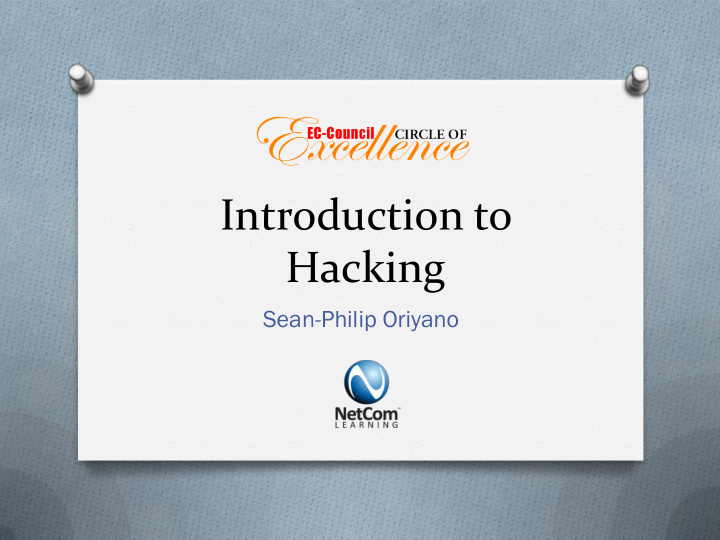



Introduction to Hacking Sean-Philip Oriyano
About Me O Over twenty years in IT Security O Author of research articles and six books O CISSP, CNDA, CEH and others O Consultant for US Military and Private corporations
Agenda O Elements of Information Security O Security Challenges O Effects of Hacking O Who is a Hacker?
What is Security? O Security – A state of well-being of information and infrastructures in which the possibility of successful yet undetected theft, tampering, and disruption of information and services is kept low or tolerable
Points to Ponder… O The Cyber Security Enhancement Act of 2002 mandates life sentences for hackers who recklessly endanger the lives of others O According to research 90 percent companies acknowledge security breaches, but only 34 percent reported the crime O The FBI estimates that 85 to 97 percent of computer intrusions are not even detected
Core Concepts Confidentiality Integrity Availability
Putting it Together Confidentiality Integrity Security Availability
Motivations for Security O Technology improvements O Reaches consumers before maturity O Networks are more common and complex O Users are much more savvy O Budgets have decreased O No or poor training O Improved attacks and smarter attackers
In the News…
Complexity Networks Software Laws Management Users Demands
Intangibles Goodwill Trust Loyalty Money
Polls
Factors Impacting Security Security Convenience
Cost of a Security Incident • Corporate espionage • Identity theft • Lost revenues • Lost of confidence • Lost productivity • Legal action
Today’s Threats Existing weaknesses in technology Misconfiguration Poor policy and planning Human error Human malice Social Networking
Types of Hackers White Suicide Grey Attackers Black
Motivations for Hackers Hacktivism Stalking Terrorism Extortion Espionage Crime Curiosity
What Makes it Possible? Ignorance Carelessness Recklessness Sharing of information Lack of training Smaller staff Social networking
What Does Security Impact? O Security touches many diverse and seemingly unrelated systems • Improving security relies on knowing the “Big picture” • Security is relevant to every system, process and person O Technical O Administrative O Physical Note: In security one must understand the big picture
Penetration Testing and Ethical Hacking O Used to test a target network O Target of Evaluation O Test a network with a client’s permission O Never go outside the project scope O Without paperwork O Emulate an actual attack
Why Pentest? O Legal requirements O Sanity check O Part of a regular audit O Build consumer confidence
Phases of Ethical Hacking Reconnaissance Scanning Gaining Access Maintaining Access Covering Tracks
Approaches to Ethical Hacking Remote network Physical Remote entry access Tools Social Local engineering network Stolen equipment
Ethical Hacking Tests Black Grey White Box Box Box
Steps in Ethical Hacking O Step 1: Talk to your client on the needs of testing O Step 2: Prepare NDA documents and ask the client to sign them O Step 3: Prepare an ethical hacking team and draw up schedule for testing O Step 4: Conduct the test O Step 5: Analyze the results and prepare a report O Step 6: Deliver the report to the client
Should You Pentest? O Not a bad idea O May be a legal requirement O Can help validate systems O Can find holes O Can keep high state of readiness O Can find outdated practices O Yes
What We’ve Covered O Elements of Information Security O Security Challenges O Effects of Hacking O Who is a Hacker?
Recommend
More recommend